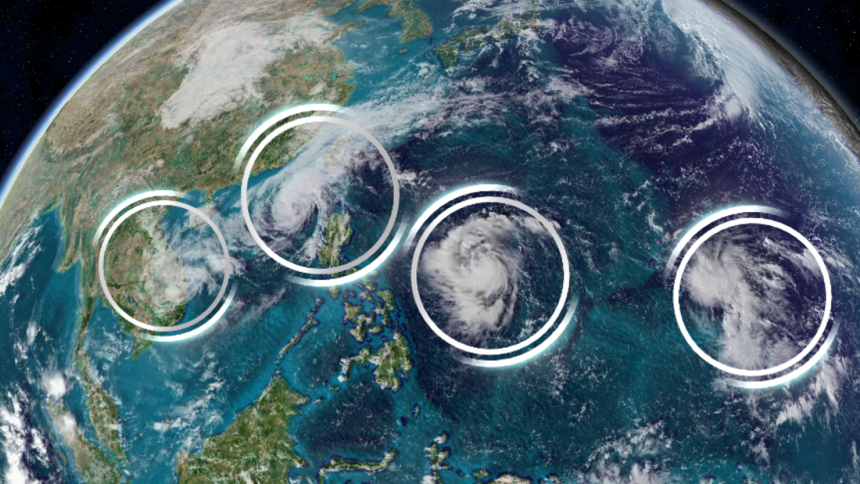CNN
—
Four separate storm systems are churning their way through the West Pacific simultaneously, a rare occurrence resulting from warmer oceans that threatens to bring more misery to the storm-weary Philippines.
It is the first time that four named storms have existed at the same time in November since records began in 1951, Japan’s Meteorological Agency confirmed to CNN Tuesday. It’s also the first time in seven years that it has happened in any month.
Satellite images from the Joint Typhoon Warning Center show the four storms spanning the vast West Pacific basin, from Vietnam to Guam.
They are Typhoon Yinxing, Typhoon Toraji, Tropical Storm Usagi and Tropical Storm Man-Yi.
The Philippines is struck by multiple storms annually, but the relentless pace of successive typhoons in the last month has complicated recovery efforts and thousands of people remain in evacuation shelters.
Typhoon Yinxing hit the northeastern Philippines on Thursday, with winds equivalent to a Category 4 Atlantic hurricane. There were no casualties reported but the storm brought torrential rain, storm surges and landslides.

After moving through the Philippines and into the South China Sea, Yinxing drifted west toward the Hainan Province of China before veering south to Vietnam, where it is currently unleashing heavy rains on the country.
Philippines President Ferdinand Marcos Jr. visited communities in Cagayan and Iloco Norte, which were impacted by Typhoon Yinxing.
“While we’re truly grateful that no lives were lost, the damage it left behind has affected homes, schools and livelihoods,” Marcos told residents in Cagayan while handing out food and aid packages on Sunday. “As we focus on recovery, we’re also preparing for another storm that may come our way.”
The next day Typhoon Toraji slammed into the eastern coast of Luzon’s Aurora Province with winds the equivalent of a Category 1 Atlantic hurricane, prompting the evacuation of thousands more people.
Toraji, now a tropical storm, is expected to weaken as it moves through the South China Sea and could bring pockets of rainfall over 100 mm (4 inches) to parts of southeastern China.
But the Philippines is bracing for yet another major storm, its third in five days.
Tropical Storm Usagi is located about 750 kilometers (460 miles) northeast of Luzon and is expected to strengthen to a typhoon by Tuesday evening local time as it approaches the Philippines.
The fourth storm on the heels of Usagi is Tropical Storm Man-Yi, which is currently about 430 kilometers (265 miles) east of Rota, Guam. Man-Yi is expected to continue moving west, reaching typhoon strength Friday morning, and could potentially hit the northeastern Philippines by early next week.
It is unclear whether Usagi and Man-Yi will directly make landfall, but heavy rain, gusty winds and dangerous storm surges are still expected.

Millions affected by successive storms
The Philippines has borne the brunt of the typhoon activity in the Pacific with six named storms already making direct landfall this year.
Tropical Storm Trami and Typhoon Kong-Rey brought severe flooding and landslides to the northern Philippines’ main island of Luzon in late October, killing a combined 150 people.
More than 9 million people were affected by the two storms, with almost 300,000 displaced, according to the Philippines disaster response center.
But as authorities raced to deliver relief to remote communities, two more storms made landfall.
Southeast Asia is already one of the most climate vulnerable regions of the world, experts warn, making it more susceptible to extreme weather like heatwaves, storm surges and floods.
Ocean temperatures have been historically warm this year, and hotter oceans provide a huge source of energy for storms to strengthen and grow.
Warmer oceans are being supercharged by humans burning fossil fuels. They are also a major factor behind more significant storms appearing later in the year and scientists say this could become more commonplace in the future.
So far this year, the Philippines capital Manila and parts of Luzon have seen devastating flooding from Typhoon Gaemi in July. In September, the country was also hit by powerful Typhoon Yagi, which left dozens dead after sweeping across southern China and Southeast Asia.



